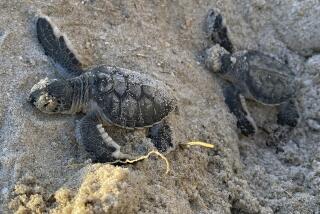ORANGE : Fans Shell Out to See Turtle Show
- Share via
Turtles these days have a bigger claim to fame than just being one of the longest-surviving creatures on the planet--dating back 200 million years to the dinosaur era.
In addition to a commercialized turtle craze, spurred by the recent success of the “Teenage Mutant Ninja Turtles” film, word is out that the four-legged, hard-shelled reptiles also make great pets that can be just as lovable as furry cats and dogs.
At least that’s what aficionados attending a turtle and tortoise exhibit at Chapman College were saying Sunday.
“They’ve all got different personalities,” said Gwen Ferguson, who has had pet turtles for about 30 years. “I’ve had some that will follow you around like a puppy dog and scratch at the back door.”
“They’re very restful and quiet,” agreed Brenda Hopkins, who helped organize the four-day symposium on turtles and tortoises, sponsored by the college and the Orange County chapter of the California Turtle and Tortoise Club. “It has a very calming effect on me to sit outside in the afternoon and watch them.”
The exhibit, which came on the final day of the symposium, drew more than 2,500 people to the college gymnasium at $2 per person, organizers said. From Thursday to Saturday, turtle enthusiasts paying to attend the symposium were offered a series of lectures and workshops dealing with turtle health, breeding and environmental issues surrounding the creatures and their survival in the modern world.
In California, the primary environmental concerns involve the dwindling numbers of desert tortoises--which are protected as an endangered species under state law--and the increasing numbers of sea turtles that die from being entangled in shrimping nets, Hopkins said.
But there is also the problem of mistreatment by owners, club members said, mostly because turtle owners sometimes do not understand proper methods of care and feeding.
Standing shoeless inside a plastic wading pool lined with paper, exhibitor Kris Metzger cradled a weathered-looking, foot-long desert tortoise in her arms as she spoke to interested bystanders.
“I rescued her,” Metzger said, rocking back and forth as if the tortoise were a newborn infant. “She had been used as a soccer ball by four boys.”
Heaving a frustrated sigh, Hopkins said that the recent “Teenage Mutant Ninja Turtles” craze has spurred a resurgence in the popularity of turtles as pets and a corresponding increase in negligent care by uneducated turtle owners.
“People get this cute little thing at the pet store, but they’re not always told how to take care of it,” she said. Turtles “do well in captivity, but you have to understand their needs . . . and be able to duplicate their native environment and foods. If one person learns something about that here today, it’s been a success.”
Many turtle fans are fascinated by the creatures’ knack for survival: They’ve survived for millions of years on the planet, and their average life span ranges from 50 to more than 100 years. One photo-and-art exhibit showed recurring turtle themes in ancient, pre-Columbian artwork and architecture, while others stressed that the survival of turtles in today’s polluted environment could be significant to the survival of mankind.
“See the turtle as a symbol of nature,” read a sign in an extensive exhibit by Aaron Hamel of Laguna Beach, who used photos and three-dimensional models to contrast the natural environments of turtles with examples of exploitation at breeding farms and in manufacturing tortoise-shell products.
“People look at my exhibit and get on guilt trips,” said Hamel, who also provided information on the endangerment of sea turtles and desert tortoises.
Other displays offered an array of turtle-shaped and turtle-printed products, turtle artwork, veterinary advice and the latest in turtle aquariums.
More to Read
Sign up for Essential California
The most important California stories and recommendations in your inbox every morning.
You may occasionally receive promotional content from the Los Angeles Times.










